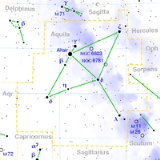
31 Aquilae
Encyclopedia
31 Aquilae (b Aquilae) is a subgiant star
in the constellation
Aquila
. Its apparent magnitude
is 5.17. Its age is probably similar to NGC 188
,the oldest open cluster known, which was calculated to be over 5 billion years. For its age, it is surprisingly metal rich, contrary to common assumptions that the oldest stars should be metal-poor.
team has set limits to the presence of one or more planets around 31 Aquilae with masses between 0.22 and 1.9 Jupiter masses and average separations spanning between 0.05 and 5.2 Astronomical Units.
Subgiant star
A subgiant star is a star that is slightly brighter than a normal main-sequence star of the same spectral class, but not as bright as true giant stars...
in the constellation
Constellation
In modern astronomy, a constellation is an internationally defined area of the celestial sphere. These areas are grouped around asterisms, patterns formed by prominent stars within apparent proximity to one another on Earth's night sky....
Aquila
Aquila (constellation)
Aquila is a stellar constellation. Its name is Latin for 'eagle' and it is commonly represented as such. In mythology, Aquila was owned by the Roman god Jupiter and performed many tasks for him....
. Its apparent magnitude
Apparent magnitude
The apparent magnitude of a celestial body is a measure of its brightness as seen by an observer on Earth, adjusted to the value it would have in the absence of the atmosphere...
is 5.17. Its age is probably similar to NGC 188
NGC 188
NGC 188 is an open cluster in the constellation Cepheus. It was discovered by John Herschel in 1825.Unlike most open clusters that drift apart after a few million years because of the gravitational interaction of our galaxy, NGC 188 lies far above the plane of the galaxy and is one of the most...
,the oldest open cluster known, which was calculated to be over 5 billion years. For its age, it is surprisingly metal rich, contrary to common assumptions that the oldest stars should be metal-poor.
Hunt for substellar objects
No certain substellar companion has been detected so far around 31 Aquilae. McDonald ObservatoryMcDonald Observatory
The McDonald Observatory is an astronomical observatory located near the unincorporated community of Fort Davis in Jeff Davis County, Texas, United States. The facility is located on Mount Fowlkes and Mount Locke in the Davis Mountains of West Texas...
team has set limits to the presence of one or more planets around 31 Aquilae with masses between 0.22 and 1.9 Jupiter masses and average separations spanning between 0.05 and 5.2 Astronomical Units.
Components
| NAME | Right ascension Right ascension Right ascension is the astronomical term for one of the two coordinates of a point on the celestial sphere when using the equatorial coordinate system. The other coordinate is the declination.-Explanation:... |
Declination Declination In astronomy, declination is one of the two coordinates of the equatorial coordinate system, the other being either right ascension or hour angle. Declination in astronomy is comparable to geographic latitude, but projected onto the celestial sphere. Declination is measured in degrees north and... |
Apparent magnitude Apparent magnitude The apparent magnitude of a celestial body is a measure of its brightness as seen by an observer on Earth, adjusted to the value it would have in the absence of the atmosphere... (V) |
Spectral type | Database references |
|---|---|---|---|---|---|
| 31 Aquilae B (HD 231345) | 19h 24m 51.8595s | +11° 57' 14.692 | 8.56 | G0 | Simbad |
| 31 Aquilae C (BD+11 3833C) | 19h 24m 50.8s | +11° 57' 36 | 10.6 | Simbad |

